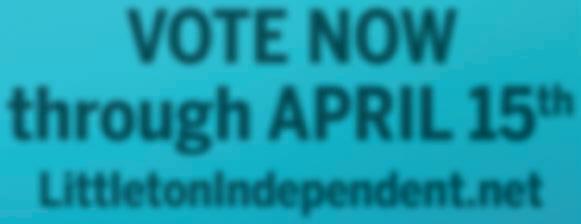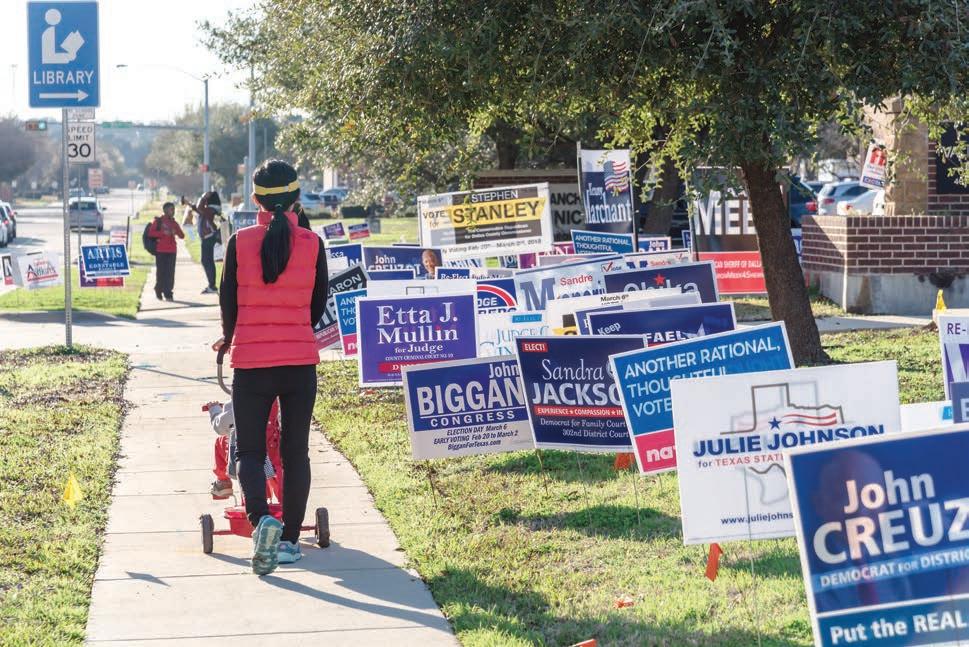
6 minute read
Littleton will assess yard sign policy after election confusion

BY NINA JOSS NJOSS@COLORADOCOMMUNITYMEDIA.COM
Littleton’s Uni ed Land Use Code, adopted by the city in 2021, describes rules for various types of signs. Among regulations regarding accessway signs, ags, awning signs, marquee signs, pole signs, window signs and more, there is no speci c section related to yard signs.
As a result, signs that share pride for student athletes, announce open houses and promote political campaign messages have unclear regulations. is spring, Littleton City Council and sta will begin to discuss and clarify regulations for yard signs, spurred by inconsistencies they found in the code during the March 7 special election season.
Social Bar & Lounge opens second location in Littleton
Brings neighborhood feel
BY RACHEL LORENZ SPECIAL TO COLORADO COMMUNITY MEDIA
Soon after opening the rst one, he knew he wanted a second, said Steve Cominsky, founder of Social Bar & Lounge. e business marked the launch of its Littleton Village location with a celebration attended by one mayor, three city council members and scores of Littleton Business Chamber members and guests in February. e after-work crowd milled around the establishment’s U-shaped bar and admired its plush couches and colorful armchairs.
“It looks just like Littleton Village’s living room in there,” Littleton e new Social Bar & Lounge is housed on the rst oor of a three-story apartment building in Littleton Village. e development,

Mayor Kyle Schlachter said to the crowd moments before Cominsky cut a red ribbon strung across the stairs leading to the bar’s double glass doors.

On March 7, citizens overwhelmingly rejected ballot question 300, which proposed changes to the city charter sections about initiatives and referendums.



Right-of-way violations
In the days before the election, some proponents of ballot question 300 voiced concerns that city ofcials were removing their “Yes on 300” yard signs. ese proponents said they felt the city was selectively
SEE SIGNS, P2 enforcing its sign policies, specically targeting signs in support of the ballot item. e ULUC prohibits any signs other than those required by a governmental authority from being in the right-of-way.

Some proponents have since pointed to the city’s removal of their signs as a reason for the election’s results, which showed 71% of voters against the measure.

Signs the city removed or relocated in the weeks leading up to the election were illegally placed in the rightof-way, said Jennifer Henninger, Littleton’s community development director who oversees the code compliance division. Because her team is short-sta ed, she participates in enforcing code compliance.
A right-of-way is an area of land through which someone other than the property owner is granted access to pass, such as a public street, median, space between curb and sidewalk or other space that could be used for a public utility.
“When (signs) start to be in the public right-of-way, they’re going to interfere with line of sight,” Henninger said. “If you’re at an intersection and somebody’s put a temporary sign there and it’s in my line of sight to (look) to see if a car is coming, there’s a public safety issue there.”
Generally, signs should be placed behind sidewalks, at least ten feet from the edge of the pavement if there is no sidewalk and at least two feet behind power poles to stay out of the right-of-way, Henninger said. A map at https://gis.arapahoegov. com/ArapaMAP/ shows very general right-of-way lines but is not completely accurate, she added.
Community members can report signs in the right-of-way at https:// www.littletonco.gov/Government/ City-Services/SeeClickFix-Littleton and the code compliance team will address them.
Code complaints regarding signs normally increase during election seasons, Henninger said, adding that the city received 34 temporary sign complaints in the week before the election.
Henninger said her sta removed all signs that were in the right-ofway, which included “Yes on 300” signs, “No on 300” signs and other signs that were unrelated to the elec- tion. e ULUC gives city o cials the right to remove signs in public rightsof-way without notice to the owner.
When her team removes campaign signs, they call the point of contact listed on the campaign so they can retrieve their signs, she said. When the city’s removal of “Yes on 300” signs sparked frustration from some of its proponents, her team started to give property owners notices about sign code violations, she said.
What is a yard sign?
John Marchetti, the point of contact for the “Yes on 300” signs, asked city sta to clarify their rules after they removed some of his campaign’s signs. In response, they e-mailed him a document outlining three rules.
Along with prohibiting signs in rights-of-way, it limited political signs to six square feet per side and stated they must be removed within ten calendar days of the election.
While the city was removing signs in the right-of-way, Marchetti was confused why o cials were not enforcing the size limitations outlined on the document. He said he saw some “No on 300” signs that exceeded the maximum size allowed.
Henninger said the document included out-of-date information and the city should have been more careful before sending it out. It was written before the ULUC, so its rules were based on the old code, she said.
“We pulled something that we’ve had and just kind of rebranded it,” she said. “We needed to have slowed down and done some cross-checking. I will completely admit that.” is mistake brought to light the fact that yard signs do not perfectly t any of the sign categories in the ULUC, she said. e closest section is that on “temporary signs,” which includes size and duration limitations for various types of signs that are not permanantly a xed to the ground.
Temporary signs, however, require a permit, according to the code. In the eyes of city o cials, it didn’t make sense to make people pay for permits for their campaign signs.
“When we look carefully at our code, it suggests that all temporary signs, whether they’re athlete support signs, real estate signs, political signs, banners… they all require permits and permit fees,” City Manager Jim Becklenberg said. “I agreed with sta that that is certainly not the intent, in our eyes, of the code to require every family with an athlete support sign or anyone having an open house with a yard sign to come in and apply for a permit and pay for an application fee.”
This spring, Littleton City Council and sta will begin to discuss and clarify regulations for yard signs, spurred by inconsistencies they found in the code during the March 7 special election season.

To be consistent in their application of the code, city o cials said they chose to not enforce speci c temporary sign rules on yard signs during the recent election season — meaning they did not charge for permits nor enforce size limitations.
“Instead of starting a permit program in the middle of the election… we said, “ at doesn’t make sense,’” Becklenberg said. “We’ll come back to that and clarify that in the next code update, which is scheduled to happen this summer.”
Right-of-way rules, however, apply to all signs and are a matter of public safety, so this enforcement remained.
“ at was consistent and more straightforward to enforce,” Becklenberg said.

With the city planning to reassess yard sign rules, Marchetti said he maintains his belief that o cials enforced the code selectively in order to negatively a ect “Yes on 300” campaigners during the special election season. He said the city reassessing the rules after the election seems like backpedaling.
Next steps e ULUC was intended to be a “living document” with modi cations and adjustments made over the years, Henninger said.
Temporary signs will be included as a topic in council’s upcoming discussions on code updates,. “I think we’ll be talking about whether we need a category of sign for temporary yard signs,” Becklenberg said.
He noted that U.S. Supreme Court decisions prohibit municipalities from regulating signs based on their content, so all yard signs will need to be treated in one category. ere will be public meetings and public comment at both the planning commission level and the city council level about all potential changes to the code, including any proposed sign regulations, Becklenberg said.
Henninger said she is grateful the community helped the city notice problems in the ULUC that need to be addressed.
“I’d like to thank the community for bringing to our attention some inconsistencies in our code,” she said.
“We welcome the feedback and the input of ‘How do we make it better?’” e city hopes to clarify the rules this summer, in advance of any campaign activity next fall, Becklenberg said.










